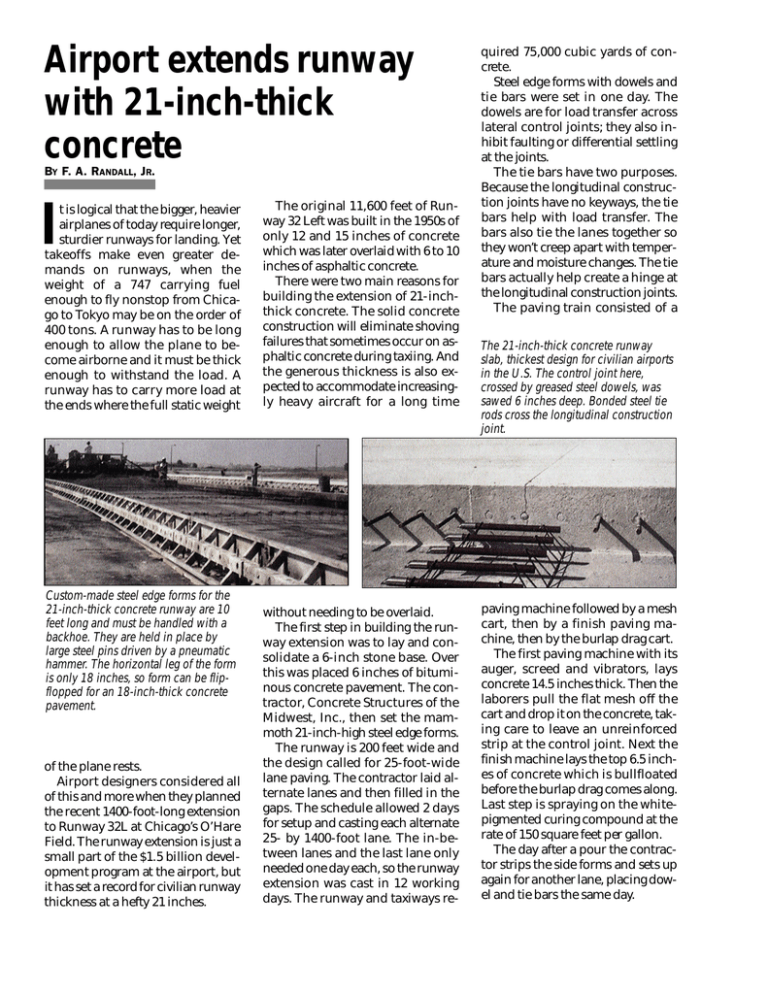
Airport extends runway
with 21-inch-thick
concrete
BY F. A. RANDALL, JR.
I
t is logical that the bigger, heavier
airplanes of today require longer,
sturdier runways for landing. Yet
takeoffs make even greater demands on runways, when the
weight of a 747 carrying fuel
enough to fly nonstop from Chicago to Tokyo may be on the order of
400 tons. A runway has to be long
enough to allow the plane to become airborne and it must be thick
enough to withstand the load. A
runway has to carry more load at
the ends where the full static weight
Custom-made steel edge forms for the
21-inch-thick concrete runway are 10
feet long and must be handled with a
backhoe. They are held in place by
large steel pins driven by a pneumatic
hammer. The horizontal leg of the form
is only 18 inches, so form can be flipflopped for an 18-inch-thick concrete
pavement.
of the plane rests.
Airport designers considered all
of this and more when they planned
the recent 1400-foot-long extension
to Runway 32L at Chicago’s O’Hare
Field. The runway extension is just a
small part of the $1.5 billion development program at the airport, but
it has set a record for civilian runway
thickness at a hefty 21 inches.
The original 11,600 feet of Runway 32 Left was built in the 1950s of
only 12 and 15 inches of concrete
which was later overlaid with 6 to 10
inches of asphaltic concrete.
There were two main reasons for
building the extension of 21-inchthick concrete. The solid concrete
construction will eliminate shoving
failures that sometimes occur on asphaltic concrete during taxiing. And
the generous thickness is also expected to accommodate increasingly heavy aircraft for a long time
without needing to be overlaid.
The first step in building the runway extension was to lay and consolidate a 6-inch stone base. Over
this was placed 6 inches of bituminous concrete pavement. The cont ra c t o r, Concrete St ru c t u res of the
Midwest, Inc., then set the mammoth 21-inch-high steel edge forms.
The runway is 200 feet wide and
the design called for 25-foot-wide
lane paving. The contractor laid alternate lanes and then filled in the
gaps. The schedule allowed 2 days
for setup and casting each alternate
25- by 1400-foot lane. The in-between lanes and the last lane only
needed one day each, so the runway
extension was cast in 12 working
days. The runway and taxiways re-
quired 75,000 cubic yards of concrete.
Steel edge forms with dowels and
tie bars were set in one day. The
dowels are for load transfer across
lateral control joints; they also inhibit faulting or differential settling
at the joints.
The tie bars have two purposes.
Because the longitudinal construction joints have no keyways, the tie
bars help with load transfer. The
bars also tie the lanes together so
they won’t creep apart with temperature and moisture changes. The tie
bars actually help create a hinge at
the longitudinal construction joints.
The paving train consisted of a
The 21-inch-thick concrete runway
slab, thickest design for civilian airports
in the U.S. The control joint here,
crossed by greased steel dowels, was
sawed 6 inches deep. Bonded steel tie
rods cross the longitudinal construction
joint.
paving machine followed by a mesh
cart, then by a finish paving machine, then by the burlap drag cart.
The first paving machine with its
auger, screed and vibrators, lays
concrete 14.5 inches thick. Then the
laborers pull the flat mesh off the
cart and drop it on the concrete, taking care to leave an unre i n f o rc e d
strip at the control joint. Next the
finish machine lays the top 6.5 inches of concrete which is bullfloated
before the burlap drag comes along.
Last step is spraying on the whitepigmented curing compound at the
rate of 150 square feet per gallon.
The day after a pour the contractor strips the side forms and sets up
again for another lane, placing dowel and tie bars the same day.
Control joints are spaced at 25foot centers. They are sawed 6 inches deep “as soon as the concrete is
ready.” Later, the tops of the cuts are
double-cut 3⁄8 inch wide for the joint
sealant groove.
Credits
Concrete Contractor: Concrete Structures of the Midwest, Inc., West Chicago, Illinois
President: Anthony C. Aiello
Project Manager: Al Benson
Superintendent: Charles Caruso
PUBLICATION #C870066
Copyright © 1989, The Aberdeen Group
All rights reserved

